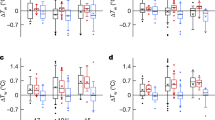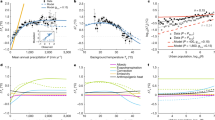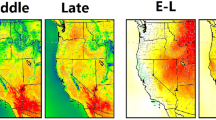Abstract
The urban heat island (UHI), a common phenomenon in which surface temperatures are higher in urban areas than in surrounding rural areas, represents one of the most significant human-induced changes to Earth’s surface climate1,2. Even though they are localized hotspots in the landscape, UHIs have a profound impact on the lives of urban residents, who comprise more than half of the world’s population3. A barrier to UHI mitigation is the lack of quantitative attribution of the various contributions to UHI intensity4 (expressed as the temperature difference between urban and rural areas, ΔT). A common perception is that reduction in evaporative cooling in urban land is the dominant driver of ΔT (ref. 5). Here we use a climate model to show that, for cities across North America, geographic variations in daytime ΔT are largely explained by variations in the efficiency with which urban and rural areas convect heat to the lower atmosphere. If urban areas are aerodynamically smoother than surrounding rural areas, urban heat dissipation is relatively less efficient and urban warming occurs (and vice versa). This convection effect depends on the local background climate, increasing daytime ΔT by 3.0 ± 0.3 kelvin (mean and standard error) in humid climates but decreasing ΔT by 1.5 ± 0.2 kelvin in dry climates. In the humid eastern United States, there is evidence of higher ΔT in drier years. These relationships imply that UHIs will exacerbate heatwave stress on human health in wet climates where high temperature effects are already compounded by high air humidity6,7 and in drier years when positive temperature anomalies may be reinforced by a precipitation–temperature feedback8. Our results support albedo management as a viable means of reducing ΔT on large scales9,10.
This is a preview of subscription content, access via your institution
Access options
Subscribe to this journal
Receive 51 print issues and online access
$199.00 per year
only $3.90 per issue
Buy this article
- Purchase on Springer Link
- Instant access to full article PDF
Prices may be subject to local taxes which are calculated during checkout




Similar content being viewed by others
References
Kalnay, E. & Cai, M. Impact of urbanization and land-use change on climate. Nature 423, 528–531 (2003)
Zhou, L. M. et al. Evidence for a significant urbanization effect on climate in China. Proc. Natl Acad. Sci. USA 101, 9540–9544 (2004)
Grimm, N. B. et al. Global change and the ecology of cities. Science 319, 756–760 (2008)
Voogt, J. A. & Oke, T. R. Thermal remote sensing of urban climates. Remote Sens. Environ. 86, 370–384 (2003)
Taha, H. Urban climates and heat islands: albedo, evapotranspiration, and anthropogenic heat. Energy Build. 25, 99–103 (1997)
Fischer, E. M. & Schär, C. Consistent geographical patterns of changes in high-impact European heatwaves. Nature Geosci. 3, 398–403 (2010)
Smith, T. T., Zaitchik, B. F. & Gohlke, J. M. Heat waves in the United States: definitions, patterns and trends. Clim. Change 118, 811–825 (2013)
Schär, C. et al. The role of increasing temperature variability in European summer heatwaves. Nature 427, 332–336 (2004)
Akbari, H., Menon, S. & Rosenfeld, A. Global cooling: increasing world-wide urban albedos to offset CO2 . Clim. Change 94, 275–286 (2009)
Georgescu, M., Moustaoui, M., Mahalov, A. & Dudhia, J. Summer-time climate impacts of projected megapolitan expansion in Arizona. Nature Clim. Change 3, 37–41 (2013)
Oke, T. R. The energetic basis of the urban heat-island. Q. J. R. Meteorol. Soc. 108, 1–24 (1982)
Grimmond, S. Urbanization and global environmental change: local effects of urban warming. Geogr. J. 173, 83–88 (2007)
Arnfield, A. J. Two decades of urban climate research: a review of turbulence, exchanges of energy and water, and the urban heat island. Int. J. Climatol. 23, 1–26 (2003)
Roth, M., Oke, T. R. & Emery, W. J. Satellite-derived urban heat islands from 3 coastal cities and the utilization of such data in urban climatology. Int. J. Remote Sens. 10, 1699–1720 (1989)
Imhoff, M. L., Zhang, P., Wolfe, R. E. & Bounoua, L. Remote sensing of the urban heat island effect across biomes in the continental USA. Remote Sens. Environ. 114, 504–513 (2010)
Peng, S. S. et al. Surface urban heat island across 419 global big cities. Environ. Sci. Technol. 46, 696–703 (2012)
Clinton, N. & Gong, P. MODIS detected surface urban heat islands and sinks: global locations and controls. Remote Sens. Environ. 134, 294–304 (2013)
Oleson, K. Contrasts between urban and rural climate in CCSM4 CMIP5 climate change scenarios. J. Clim. 25, 1390–1412 (2012)
Lee, X. et al. Observed increase in local cooling effect of deforestation at higher latitudes. Nature 479, 384–387 (2011)
Rotenberg, E. & Yakir, D. Contribution of semi-arid forests to the climate system. Science 327, 451–454 (2010)
Hansen, J., Sato, M. & Ruedy, R. Perception of climate change. Proc. Natl Acad. Sci. USA 109, E2415–E2423 (2012)
Li, D. & Bou-Zeid, E. Synergistic interactions between urban heat islands and heat waves: the impact in cities is larger than the sum of its parts. J. Appl. Meteorol. Climatol. 52, 2051–2064 (2013)
Gallo, K. P., Adegoke, J. O., Owen, T. W. & Elvidge, C. D. Satellite-based detection of global urban heat-island temperature influence. J Geophys Res. 107, 4776 (2002)
Tran, H., Uchihama, D., Ochi, S. & Yasuoka, Y. Assessment with satellite data of the urban heat island effects in Asian mega cities. Int. J. Appl. Earth Obs. Geoinf. 8, 34–48 (2006)
Mackey, C. W., Lee, X. & Smith, R. B. Remotely sensing the cooling effects of city scale efforts to reduce urban heat island. Build. Environ. 49, 348–358 (2012)
Oleson, K. W., Bonan, G. B., Feddema, J. & Vertenstein, M. An urban parameterization for a global climate model. Part II: sensitivity to input parameters and the simulated urban heat island in offline simulations. J. Appl. Meteorol. Climatol. 47, 1061–1076 (2008)
Rosenzweig, C. et al. Mitigating New York City’s heat island: integrating stakeholder perspectives and scientific evaluation. Bull. Am. Meteorol. Soc. 90, 1297–1312 (2009)
Hurrell, J. W. et al. The Community Earth System Model: a framework for collaborative research. Bull. Am. Meteorol. Soc. 94, 1339–1360 (2013)
Oleson, K. et al. Technical Description of Version 4.0 of the Community Land Model (CLM) 257. Report No. NCAR/TN-478+STR (NCAR, 2010)
Qian, T. T., Dai, A., Trenberth, K. E. & Oleson, K. W. Simulation of global land surface conditions from 1948 to 2004. Part I: forcing data and evaluations. J. Hydrometeorol. 7, 953–975 (2006)
Nichol, J. et al. Urban heat island diagnosis using ASTER satellite images and ‘in situ’ air temperature. Atmos. Res. 94, 276–284 (2009)
Kalnay, E. et al. The NCEP/NCAR 40-year reanalysis project. Bull. Am. Meteorol. Soc. 77, 437–471 (1996)
Gu, L. H., Fuentes, J. D., Shugart, H. H., Staebler, R. M. & Black, T. A. Responses of net ecosystem exchanges of carbon dioxide to changes in cloudiness: results from two North American deciduous forests. J. Geophys. Res., D, Atmospheres 104, 31421–31434 (1999)
Garratt, J. R. The Atmospheric Boundary Layer (Cambridge Univ. Press, 1994)
Voogt, J. A. & Grimmond, C. S. B. Modeling surface sensible heat flux using surface radiative temperatures in a simple urban area. J. Appl. Meteorol. 39, 1679–1699 (2000)
Oleson, K. W., Bonan, G. B., Feddema, J. & Jackson, T. An examination of urban heat island characteristics in a global climate model. Int. J. Climatol. 31, 1848–1865 (2011)
Acknowledgements
This research was supported by the Ministry of Education of China (grant PCSIRT), the Yale Climate and Energy Institute, the Yale Institute of Biospheric Studies, and a Yale University Graduate Fellowship. K.O. acknowledges support from NASA grant NNX10AK79G (the SIMMER project) and the NCAR WCIASP. NCAR is sponsored by the US National Science Foundation. The model simulations were supported by the Yale University Faculty of Arts and Sciences High Performance Computing Center.
Author information
Authors and Affiliations
Contributions
X.L. designed the research. L.Z. carried out the model simulation and data analysis. R.B.S. contributed ideas to the research design. K.O. contributed ideas to the model simulation. X.L. and L.Z. drafted the manuscript.
Corresponding author
Ethics declarations
Competing interests
The authors declare no competing financial interests.
Extended data figures and tables
Extended Data Figure 1 Precipitation and population influences on MODIS-derived annual mean UHI intensity.
a, Dependence of daytime UHI on population size (r = 0.27, P = 0.027). b, Dependence of night-time UHI on precipitation (r = 0.05, P = 0.70). Red, green and blue symbols denote cities with annual mean precipitations less than 500 mm, between 500 and 1,100 mm, and over 1,100 mm, respectively. The solid line in a is the linear regression fit to the data. Parameter bounds for the regression slope are the 95% confidence interval.
Extended Data Figure 2 Time series of MODIS and model-predicted daytime ΔT and annual precipitation.
a, Billings, Montana. b, Richmond, Virginia.
Extended Data Figure 3 Relationship between interannual variations in model-predicted daytime ΔT and precipitation.
a, Correlation of ΔT and the individual biophysical components with annual precipitation at Billings, Montana. b, Same as in a except for Richmond, Virginia. c, ΔT–precipitation temporal covariance explained by different biophysical factors at Billings, Montana. d, Same as in c except for Richmond, Virginia. Lines are best linear regression fits to the data points. Parameter bounds for the regression slope are the 95% confidence interval.
Extended Data Figure 4 Albedo influence on annual mean night-time UHI intensity.
a, Dependence of night-time MODIS-derived UHI on white-sky albedo difference (that is, urban albedo minus rural albedo; r = −0.60, P < 0.001). b, Dependence of night-time modelled UHI on modelled albedo difference (r = −0.56, P < 0.001 excluding four outliers; r = −0.18, P = 0.16 with all data points). The four outliers in the upper right corner of b are coastal cities (Olympia, Washington; Seattle, Washington; Salem, Oregon; Vancouver, British Columbia) that have high biases of the modelled ΔT compared to the MODIS ΔT. Lines are linear regression fits to the data. Parameter bounds for the regression slope are the 95% confidence interval.
Rights and permissions
About this article
Cite this article
Zhao, L., Lee, X., Smith, R. et al. Strong contributions of local background climate to urban heat islands. Nature 511, 216–219 (2014). https://doi.org/10.1038/nature13462
Received:
Accepted:
Published:
Issue Date:
DOI: https://doi.org/10.1038/nature13462
This article is cited by
-
Mapping urban form into local climate zones for the continental US from 1986–2020
Scientific Data (2024)
-
Spatio-temporal Evolution Characteristics and Driving Forces of Winter Urban Heat Island: A Case Study of Rapid Urbanization Area of Fuzhou City, China
Chinese Geographical Science (2024)
-
Highly Porous Yet Transparent Mechanically Flexible Aerogels Realizing Solar-Thermal Regulatory Cooling
Nano-Micro Letters (2024)
-
Factors Influencing the Spatial Variability of Air Temperature Urban Heat Island Intensity in Chinese Cities
Advances in Atmospheric Sciences (2024)
-
The Application of Nature-Based Solutions for Urban Heat Island Mitigation in Asia: Progress, Challenges, and Recommendations
Current Environmental Health Reports (2024)
Comments
By submitting a comment you agree to abide by our Terms and Community Guidelines. If you find something abusive or that does not comply with our terms or guidelines please flag it as inappropriate.



